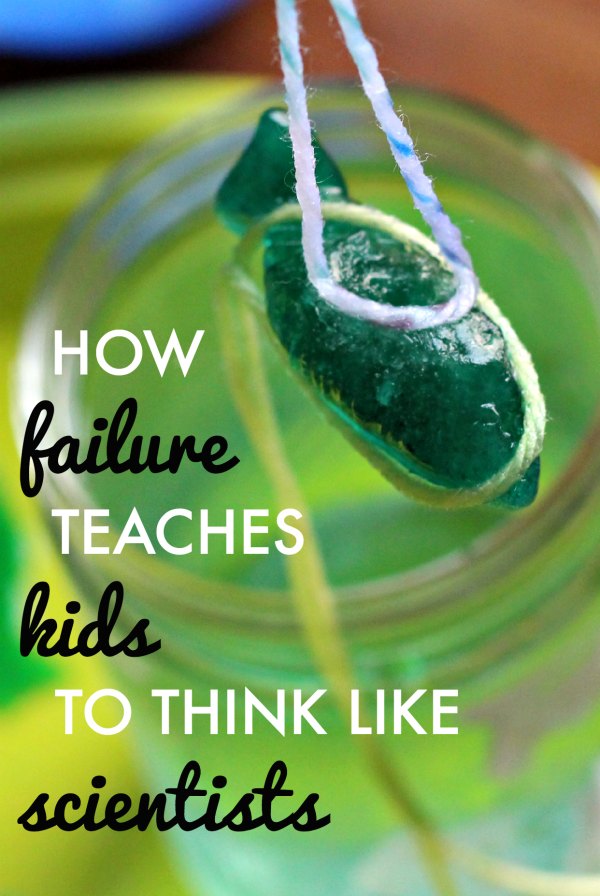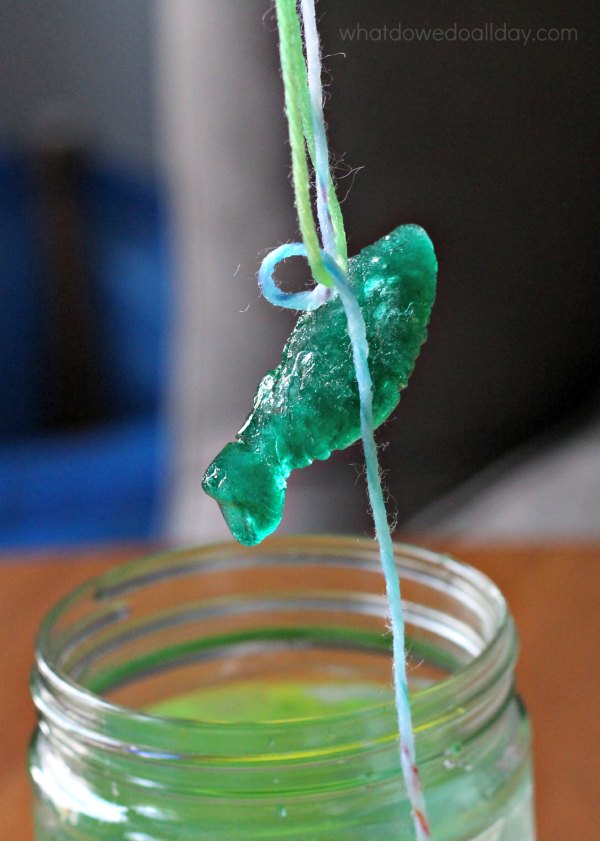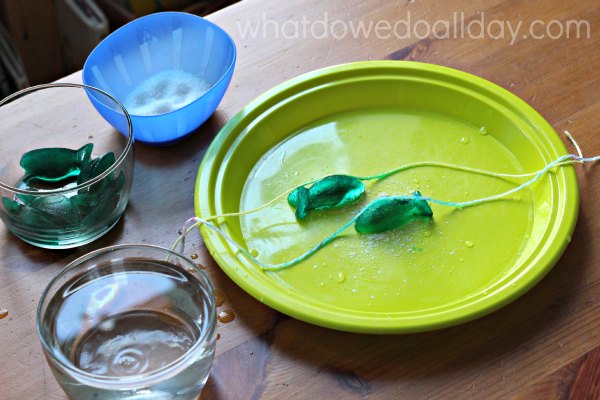This inaugural summer science camp post was supposed to show you how to do a simple science project with your kids: how to lift an ice cube with a string.
It has all the great characteristics of an easy experiment: it's quick, there are no fancy materials, there is a not-too-obvious explanation, etc. However... it turned into a different kind of exercise. It showed my kids how being a scientist takes patience and lots of do-overs.

First I will pretend that we were great and successful scientists and give you the run down of the experiment. (Then we'll get to the good stuff.) The instructions for how to lift an ice cube with string are very basic.
What you need:
- 2 ice cubes (cute shapes and color optional, and not particularly desirable as you will see)
- 2 pieces of string
- Water
- Salt
- A small bowl or glass
Instructions:
- Place the ice cubes in a bowl of water.
- Wet string and place each one across each ice cube.
- Sprinkle one string with salt.
- Wait one minute.
- Try to lift the salt-less string. Nothing happens!
- Try to lift the salt covered string. It lifts the ice cube.
- Give yourself a pat on the back for being such an awesome scientist and getting it right on the first try.
Why this works:
Salt water melts at a lower temperature than regular water. The salt melted the ice around the string, but as new water crept into its place, it refroze, "locking" the string into place.
It took us four tries to get this experiment to work. After each try, the boys and I brainstormed what we should do next. I'm not saying it was easy to get them to be patient and try again. My 5 year old, especially, wanted to move on to something else. I had to explain that scientists always have to repeat their experiments, even if they are successful on the the first try.
First. I tried making cutesy fish ice cubes. Total Failure. The boys speculated that the fish were bouncing around in the water too much and the string didn't really way to lie flat on the "cube".
Next. We tried it on a plate. Total Failure. The boys speculate the ice was not big enough, and there was not enough water.
Next. We tried it with a large, flat ice block (note cutesy ice cubes trapped inside). Partial Success. The string stuck somewhat, but the boys speculated that the ice block was too heavy for the string. I speculated maybe they should have kept their hands out of the water while we waited the requisite minute.
At this point the boys realized that I wasn't making it up that this might actually work. Since we still had a few of my ridiculous green fish ice cubes they agreed to try one more time.
Lastly. We place a fish in a jar with water, wet the string, put it on top, did not disturb the water and waited one very long minute.
Success!
MORE: Best science picture books for kids

I'm really glad I forced encouraged the boys to see the project through to completion. I want them to be problems solvers and to not give up on the first go.
What my kids learned: Scientists have to persevere! Scientists aren't always successful! Scientists must speculate, test, and compare results.
What I learned: It doesn't pay to try and be cute with fish shaped ice cubes or food coloring. I don't want my kids to ingest artificial color and it took a lot of scrubbing to get it off my silicone ice tray!
Have you ever had an experiment go awry? How did your kids handle it?
This post is part of an 8 week Summer Science Camp collaboration with Megan at Coffee Cups and Crayons. Each Thursday we will share very do-able science projects to do with the kids this summer (or anytime of year). Bookmark us and check back every week for 2 new science experiments. Or subscribe to our weekly newsletter so you don't miss a thing.
Pop over to see how Megan and her kids got on with Mentos and Coke. (link may not work before 5pm today)
Bonus! Watch the ice cube with salt and string experiment in action:








esivy says
I *love* that you shared all your trials and tribulations in getting this experiment to work. As a scientist, I can tell you that it's so true that this is the way real science works. But as a mom and a perfectionist, I always like to get things right before I show it to anybody. My kids are older, and I've been reading a lot about secondary education and about how today's kids need to learn to fail. It's hard to find examples of how you teach kids that! But this is perfect.
Erica MomandKiddo says
That's good to know for moms like me who get a lot of things wrong. LOL.
esivy says
I'm curious if you're aware of the current debate surrounding the intense high school schedule and the viewpoint that it's turning out over-achievers who "don't know how to handle failure." I'm wondering how often I encounter wording like yours due to the debate, or independent observations, if that makes any sense.
Erica MomandKiddo says
I'm not as familiar with what you mention, but I recently heard an NPR story about a school that emphasizes teaches kids resilience, which is sort of like teaching that failure is simply a part of learning.
esivy says
Very interesting!Sometimes I'm not sure if something has always been out there and I'm just now noticing, if I'm just noticing things because I'm now looking for it, or if one person with clout observed something and now everyone else is echoing the same thing (a false magnification).
Rosanne says
Thank yo so much for these fun activities 🙂 I really appreciate you saying this: "What my kids learned: Scientists have to persevere! Scientists aren’t always successful!" You know when something jumps off the page at you?! Yeah 😉 Why do I feel like I can't fail at science experiments when Thomas Edison did a whole lot before he got it right?! I think God will use this little comment you made to take our science to a whole new level as I choose to just learn from it all and not have expectations and teach my kids by my example to persevere...and in the end, yes, our expectations can sometimes then be met! 🙂 Thanks again.
Erica MomandKiddo says
Very true. Thanks for taking the time to comment.